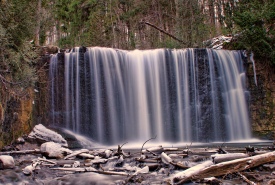Nature, the original dynamo: Understanding the relevance of resilient dynamism in conservation

River walking in the winter (Photo by Al Thompson)
“Health is the capacity of the land for self-renewal. Conservation is our effort to understand and preserve this capacity.” ~ Aldo Leopold (1949)
As heads of state, intellectuals and journalists once again gather for the 2014 World Economic Forum (WEF), here at the Nature Conservancy of Canada (NCC) we are taking a look back at 2013 — a year when we accomplished significant conservation results. It was also the year that "resilient dynamism" was the theme for the WEF’s Annual Meeting in Switzerland. There, business leaders emphasized the importance of agility and resilience in today’s volatile markets.
At first glance “resilient dynamism” may seem to have little relevance for conservation. But after considering it carefully, the theme takes on significance in the context of conservation and NCC's conservation work.
Resilient dynamism in nature
Before there was a formal discipline of economics, there was nature. Indeed, you could say that nature is the original resilient dynamo.
Resilience, or the ability to absorb change or recover from it, is what conservationists strive for in our work to protect and manage natural areas. An area is resilient because it is healthy. It is able to withstand threats such as invasive species and climatic fluctuations. A resilient natural area has an immune system that is strong enough to self-regulate instead of breaking down.
Last spring, Nature Journal featured research by Andrew MacDougall at NCC’s Cowichan Garry Oak Preserve on Vancouver Island, which put theory into practice and showed that healthy and diverse habitats bounce back better after disturbance than do degraded habitats. This was just one of many recent research studies that elegantly showed that habitats with many species are more resilient and resistant to extinction. It’s as if they have a back up plan should anything go askew.
Dynamism, or dynamics, suggests change or growth — an understanding that things are constantly in flux.
Likewise, nature is constantly changing and evolving. It is never static. Habitats are renewed seasonally through flooding or drought cycles and over longer periods of time through storms, fires, insect outbreaks and other natural processes.
Resilient dynamism at NCC
Like the natural areas it seeks to protect, NCC also strives towards organizational resilience and dynamism.
Because nature and the socioeconomic landscape change constantly, we must stay on our toes, adjusting our business practices as new information emerges. Conservation planning keeps us forward thinking; it helps us identify lands that contribute to resilient, diverse natural areas. Our planning is tailored to respond to emerging challenges, opportunities and environmental dynamics.
Our toolbox for managing lands is diverse and frequently adjusted to ensure that our actions have the desired outcomes on species and habitats. For example, instead of using the same approach to restore all areas disturbed by invasive species, we use monitoring to identify the approach that works best for a given invasive species in a given habitat type. Managing adaptively like this, informed by the evidence of our success, ensures our long-term resilience.
Looking to the future
By making sure we have healthy lands and water, and species diversity, NCC is also playing a role in improving our country's economic resilience. The two cannot be separated: without a healthy, natural environment, we will not have a sustained healthy economy.


